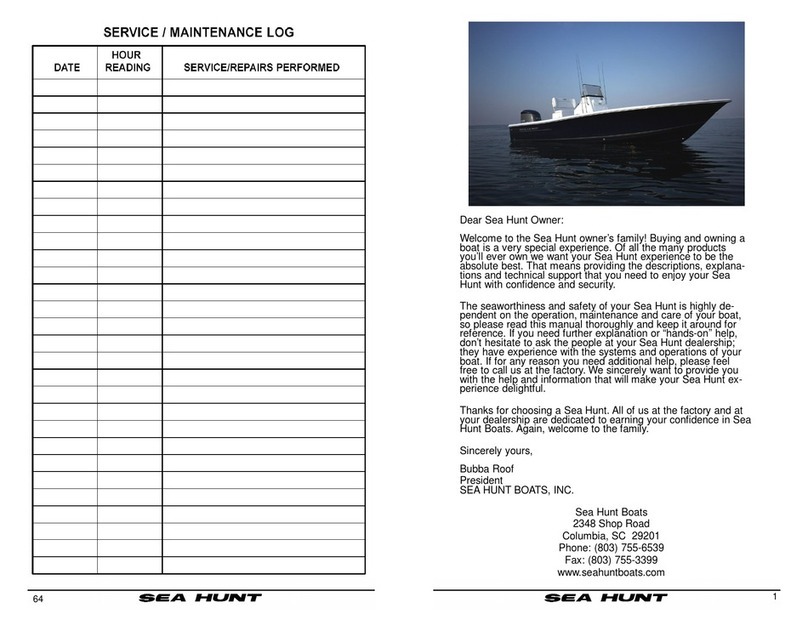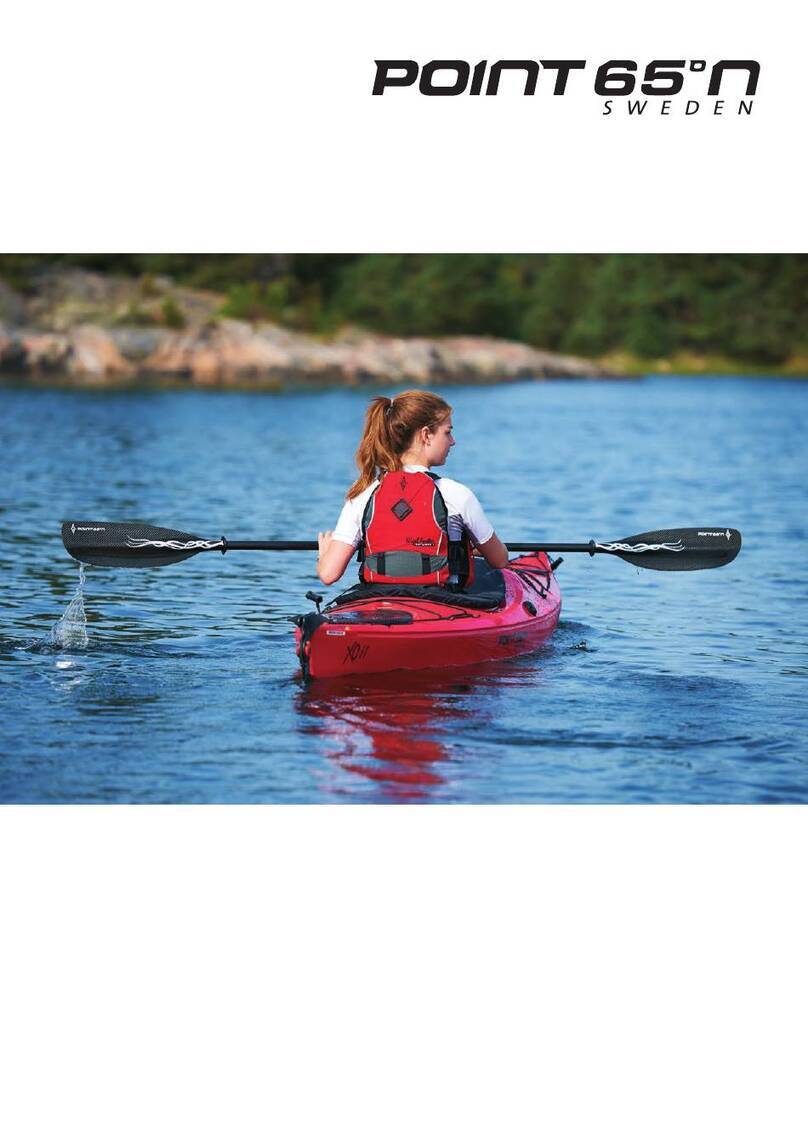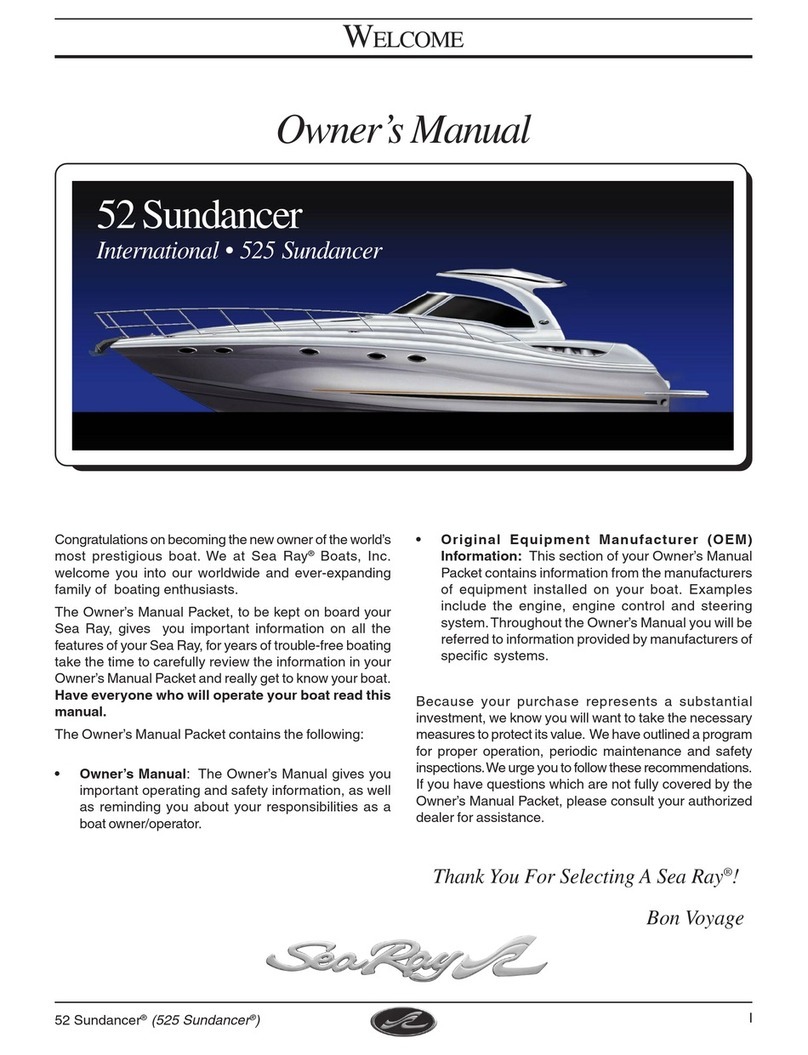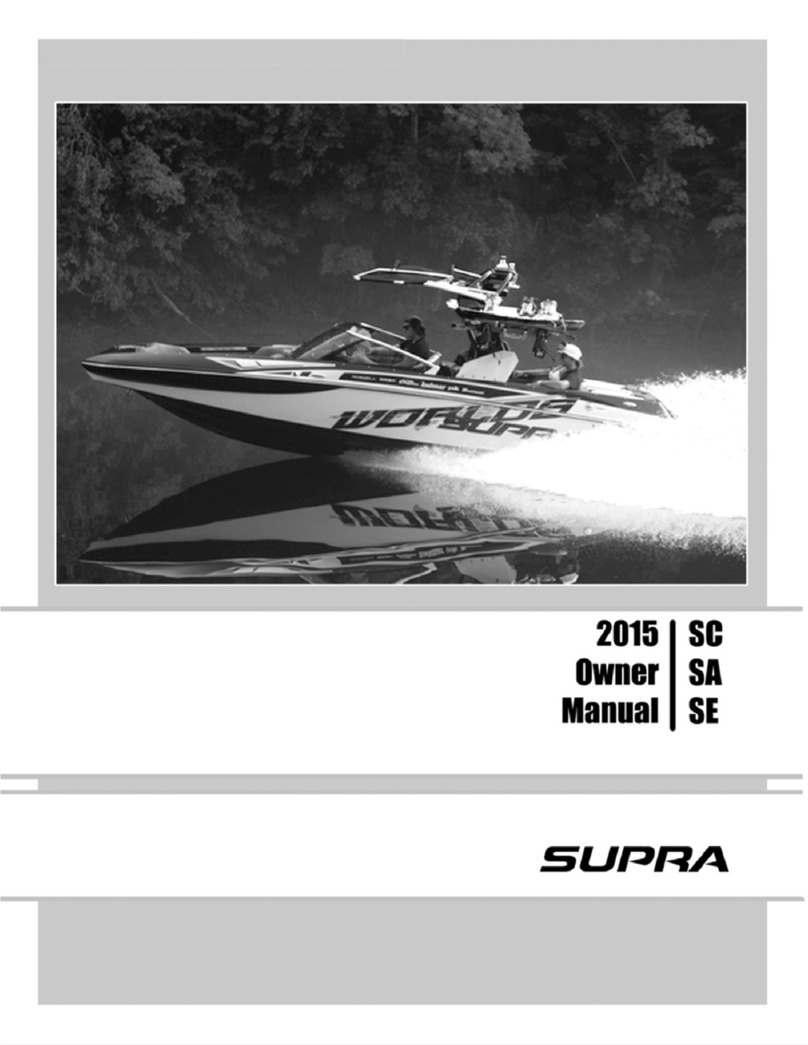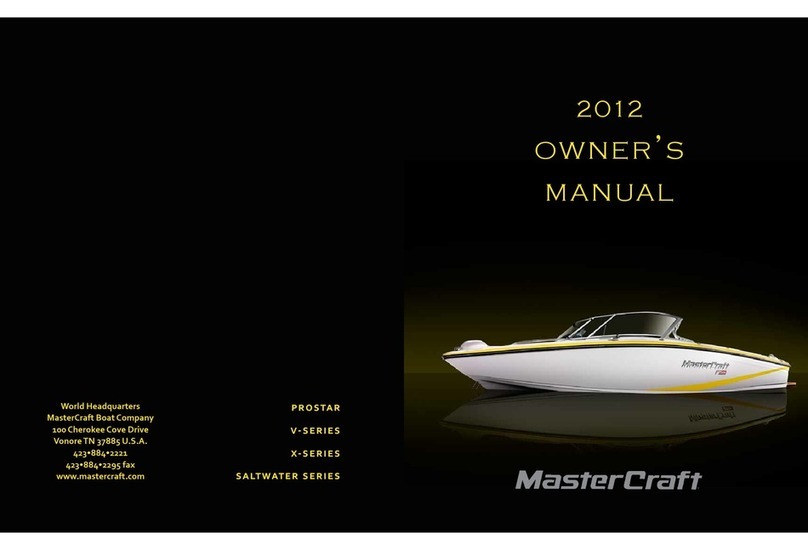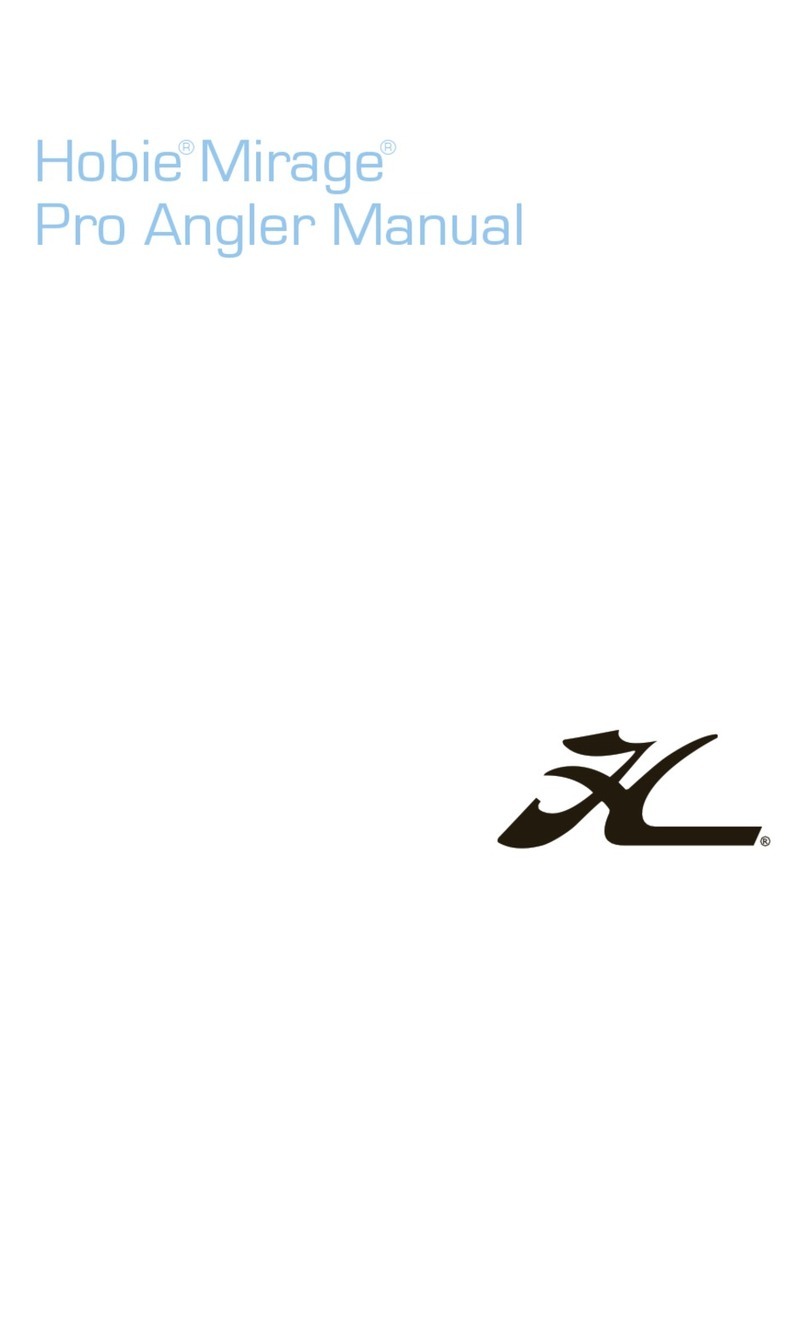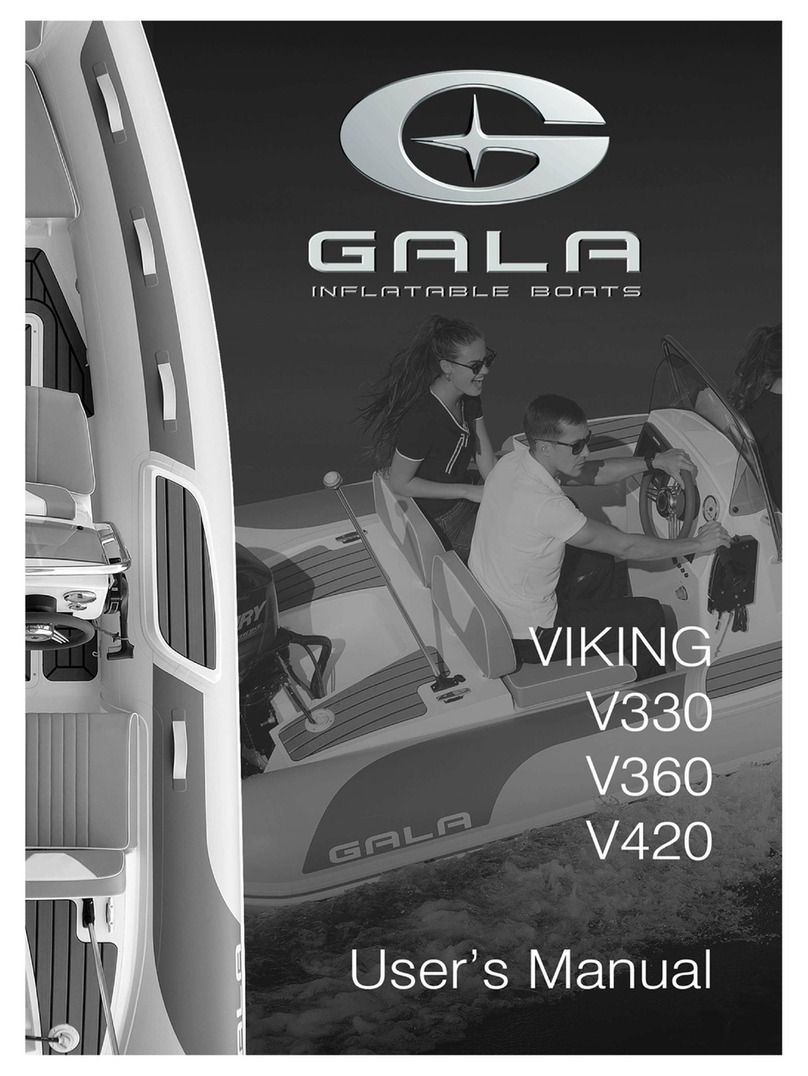Sea Hunt Triton Series User manual

1
Dear Sea Hunt Owner:
Welcome to the Sea Hunt owner’s family! Buying and owning a
boat is a very special experience. Of all the many products
you’ll ever own we want your Sea Hunt experience to be the
absolute best. That means providing the descriptions, explana-
tions and technical support that you need to enjoy your Sea
Hunt with confidence and security.
The seaworthiness and safety of your Sea Hunt is highly de-
pendent on the operation, maintenance and care of your boat,
so please read this manual thoroughly and keep it around for
reference. If you need further explanation or “hands-on” help,
don’t hesitate to ask the people at your Sea Hunt dealership;
they have experience with the systems and operations of your
boat. If for any reason you need additional help, please feel
free to call us at the factory. We sincerely want to provide you
with the help and information that will make your Sea Hunt ex-
perience delightful.
Thanks for choosing a Sea Hunt. All of us at the factory and at
your dealership are dedicated to earning your confidence in Sea
Hunt Boats. Again, welcome to the family.
Sincerely yours,
Bubba Roof
President
SEA HUNT BOATS, INC.
Sea Hunt Boats
2348 Shop Road
Columbia, SC 29201
Phone: (803) 755-6539
Fax: (803) 755-3399
www.seahuntboats.com

2
20
24
24
24
25
25
26
27
28
28
28
28
28
28
29
29
29
30
30
30
30
30
30
30
31
31
31
31
31
32
32
32
33
33
33
33
33

3
&
34
34
34
34
34
34
34
35
35
35
35
35
35
35
35
35
36
36
36
36
36
37
38
38
38
39
40
40
41
41
41
41
41
42
43
43
43
43
44
44
45
. . . . . . . . . . . .
Trolling Motor Wiring . . . . . . . . . . . . . .
. . . . . . . . . . . . . . . . . . .
. . . . . .66-68,
inside back cover

4
ORIENTATION
Your Sea Hunt has many features and accessories that have exist-
ing printed material provided by the various equipment manufacturers.
This information is compiled in a package that we will reference
throughout this manual. Consult your Sea Hunt Owner’s Manual and
Engine Manual to advise on proper operation, maintenance intervals,
specifications, warranty, and other useful information.
While reading your Sea Hunt Owner’s Manual, you will find other
technical literature referenced as resources for detailed information.
When you take delivery of your new Sea Hunt it will also consist of
several other items that you will need to become familiar with, such as
operation guides, informative labels, and product warranties. Your
Owner’s Manual can also be used to record other boat specifics such
as maintenance records and additional equipment and accessories
installed after delivery.
WARRANTY INFORMATION
The Sea Hunt warranty is located on the last page of this manual.
Upon the purchase of your new Sea Hunt boat, the dealer will fill out a
warranty card. This card will be kept on file at the dealership and at
the Sea Hunt factory. A copy will be provided for your records and
should be kept with other valuable documents for future reference. For
questions regarding your warranty please contact your dealership.
AREAS FOR DEALER ASSISTANCE
Your new Sea Hunt is built with pride and the utmost care is taken
to make your ownership experience memorable. Every Sea Hunt goes
through a rigorous quality control inspection throughout the entire
manufacturing process. Subsequent to the final factory overview your
dealer must perform additional pre-delivery checks and approve your
Sea Hunt for delivery.

5
HAZARD WARNING SYMBOLS
The hazard warning symbols shown below are applied throughout
this manual to alert the customer of potentially dangerous situations
that can lead to product damage, personal injury and/or death. We
urge you to observe these warnings and comply with all safety recom-
mendations.

6
DEALER PRE-DELIVERY / DELIVERY RESPONSIBILITIES
• Provide orientation of the general operation of your Sea Hunt pack-
age.
• A manufacturers warranty registration must be completed and
signed by both the dealer and consumer to validate and activate
applicable warranties.
• A review of all warranties, pointing out the importance of mailing
warranty and registration to various manufacturers within the re-
quired time limits.
• An explanation of safety issues regarding the use of all systems
and components.
• Guidance on acquiring local and out of area service during and out
of warranty periods.
• Review local and national regulations.
CONSUMER RESPONSIBILITIES
• The following are responsibilities of the Sea Hunt owner:
• Read and understand the express limited warranty.
• Study all literature and instructions.
• Be familiar with national and local regulations (and international if
you will be taking your boat more than 3 miles offshore).
• Examine the boat and confirm all systems are working properly at
the time of accepting delivery.
• Following 10-20 hours of operation, contact your selling dealer to
schedule a 20 hour inspection service.
• Perform proper maintenance and periodic servicing of the boat in
accordance with manufacturers recommendation in the Owner’s
Manuals.

7
BOAT MODEL IDENTIFICATION
Sea Hunt Boats has a permanent record of your boat, which is
identified through the “Hull Identification Number” (HIN). Data regard-
ing equipment and accessories, as well as dealer/shipping information
is documented when your new Sea Hunt is “Warranty Registered”.
The “Hull Identification Number” is located on the starboard side of
the transom. It is a significant source of identification and must be not-
ed in all correspondence and orders.
When contacting your dealer concerning maintenance or warran-
ties, please have all relevant information such as serial numbers (HIN)
and model number available. This information is on your copy of the
warranty card.
REGISTRATION NUMBERS
Federal and State laws require a power boat to be registered in the
state where it is primarily used. Registration numbers and validation
stickers must be displayed according to regulations. The registration cer-
tificate must be on board when boating. The boat serial number, or Hull
Identification Number (HIN), is required on the registration form. The
HIN should be included on all documents or any correspondence to pro-
vide you timely service.

8
REQUIRED SAFETY EQUIPMENT
The US Coast Guard (USCG) requires that
every boat have specific equipment on board.
Check with local regulations on mandatory
equipment apart from the list of Coast Guard re-
quirements.
FIRE EXTINGUISHER
At least one Type-1 hand held portable fire ex-
tinguisher must be carried on board. For boats
over 20’ two are required. Check extinguisher reg-
ularly for charge status.
PERSONAL FLOTATION DEVICE (PFD)
You must have a USCG approved personal
flotation device of Type I, II, or III aboard for
each passenger, in addition to one Type IV
throwable PFD. Always wear a PFD when
boating. In some states, children are required
to wear a PFD at all times. Check your local
regulations.
SOUND SIGNALING DEVICES
Your Sea Hunt is equipped with an electric
horn which meets the USCG requirements for
a sound signal device.
VISUAL DISTRESS SIGNALS
USCG approved visual distress signals are
required for day and night use when operating
on US waters. Approved signals include flares,
orange smoke, an orange distress flag, or an
electric distress light.
LIGHTING
Your Sea Hunt boat is equipped with naviga-
tion lights which comply with both Inland and
International rules.

9
ADDITIONAL RECOMMENDED EQUIPMENT
In addition to the required safety equipment, there are additional
items that will provide an extra margin of safety and convenience for
you and your passengers while boating.
- First aid kit and manual
- Anchor with at least 100’ of rode
- Mooring lines and fenders
- Combination oar/boat hook
- Non-aerosol lubricant
- Tool kit
- Spare engine fuses
(see engine operator’s manual)
- Local charts and compass
- Waterproof flashlight
- Portable AM/FM radio with weather
band
- Spare flashlight and radio batteries
- Sunglasses and sun block
Normally, this equipment is dependent on the body of water and
the length of the trip. Your dealer can assist you in selecting the appro-
priate equipment for your trip.
Keep tools and spare parts in good condition. Replace parts re-
moved from spare parts kit. Most importantly use U.S. Coast Guard
approved or marine certified parts where applicable. Conditions found
requiring corrective action should be serviced by a qualified repair-
man.

10
• Try to turn the engine OFF to prevent damage.
• Have everyone aboard put on their personal flotation device.
• If others were on board, try to locate them, and guide them to the
safety of the hull.
• STAY WITH THE BOAT! All Sea Hunt Boats under 20 feet in
length are designed to meet or exceed level flotation require-
ments. so that, if swamped, the crew may be able to bail the cock-
pit out and restart the engine. Larger models should keep a portion
of the boat above water, depending on load and degree of any
damage to the hull.
• Climb up on the hull and try to signal for assistance.
• Don’t try to swim to shore. It’s usually farther than it looks.
• Guard against swamping and capsizing; see that loaded items do
not shift in the boat and do not use too much power or speed in
turns.
EMERGENCY INFORMATION
While boating, unpleasant situations may develop. Before emergency
situations materialize you should prepare yourself on how to cope with
them, whether they happen aboard your vessel or someone else’s.
Prepare a game plan for specific situations that may occur such as fire,
man overboard or collision, to give you the confidence and ability nec-
essary for an emergency. The key factor is to remain calm, and ad-
vance planning will greatly improve your chances of doing this.
FIRES
A fire aboard your boat is very serious. In case of fire, you should im-
mediately stop your boat and shut off the engine. Have everyone
aboard put on their personal flotation device. If the fire is accessible,
use the fire extinguisher at the base of the flames using a sweeping
motion.
If the fire cannot be extinguished within a few minutes, use a distress
signal and call for help on the radio. All persons should jump over-
board and swim clear of the burning boat.
SWAMPING, FLOODING, OR CAPSIZING
A boat may capsize or swamp
when least expected. Like fires,
try to formulate a plan in advance
on what to do if it should happen.
Keep in mind the following guide-
lines:

11
COLLISIONS
If you are involved in a collision with another boat or a stationary ob-
ject (reef, sandbar, bridge, pier, etc.), first check everyone aboard for
injuries and then inspect your boat for damage.
• Attempt to plug any holes you find.
• If the boat is taking on water, have everyone put on their PFDs.
• Signal for help.
WEATHER
STORMS
Getting caught in severe weather is hazardous. The best advice for
boaters in bad weather is to STAY HOME. Check with local weather
stations, the U.S. Coast Guard, or National Weather Service broad-
casts for the latest conditions. (162.4-162.55 MHz) It is recommended
to check the weather not only before but periodically while you are
boating, as weather conditions can change rapidly. If a storm ap-
proaches,
• return to port or seek safe harbor immediately.
• make sure all persons aboard are wearing a PFD.
• reduce your speed and head into the wind as much as possible.
When a lightning storm ad-
vances certain safety precau-
tions should be taken. Dock the
boat and seek shelter on land.
If this is not possible seek ref-
uge inside the boat until the
storm has passed. Stay out of
the water! Lightning will seek a
ground when it strikes and may pass through metal components if it
hits your boat. Avoid contact with metal parts of the boat under these
conditions.
FOG
If you encounter fog, set a course using your GPS or compass and
navigational chart. Reduce your speed. Have everyone aboard act as
lookouts to prevent collisions. Sound your horn intermittently to warn
others of your presence. You must also listen for signals from other
boaters in the area.

12
EMERGENCY STOP SWITCH
Sea Hunt boats are equipped with
an emergency stop switch that is sup-
plied by the engine manufacturer. This is
a safety feature that, if used properly,
will shut the engine(s) down if the opera-
tor leaves or falls from the helm position.
This ignition shutdown switch in-
cludes a shut-off switch, switch clip, lan-
yard and lanyard clip. The lanyard clip is
attached to the operator. If a situation
arises where the boat should stop, a pull
on the cord to release the clip from the
shut-off switch will shut down the en-
gines. To reset the emergency stop
switch, simply reinstall the switch clip.
The ultimate decision to use the emer-
gency stop switch rests with the captain/
pilot.
RENDERING ASSISTANCE
The owner or operator of a vessel is required by law to render all
practical or necessary assistance to any person or vessel affected by
collision, accident or casualty. However, you should not endanger
your vessel or passengers to render assistance.
ACCIDENT REPORTING
Report all boating accidents to your local authorities. Federal regu-
lations require boat operators that are involved in an accident to submit
a written report within 48 hours. In the event of death or disappearance
notification is required immediately by phone or radio in addition to the
written report. These reports can be submitted to the State Boating Law
Administrator. Forms can be obtained through the USCG, local harbor
patrol offices, sheriff and police stations.
BOATING SAFETY TIPS
Safety is the first priority in any boating trip. Remember- the safe-
ty of your vessel and all aboard are your responsibility. The following
precautions will add to you and your passenger’s boating safety and
pleasure.
• Study all operation and maintenance manuals for your Sea Hunt
before operation. Contact your dealer with any questions or con-
cerns. Proper operation and maintenance will insure quality per-
formance and the longevity of your boat.

13
• A written float plan left with a reliable person will be valuable in-
formation if you have a mishap and do not return on time. Upon
returning inform the holder of the float plan to prevent false
alarms about your safety.
• Never operate (or allow anyone else to operate) your boat while
under the influence of drugs or alcohol.
• Do not allow individuals under 16 years of age to operate your
boat. Inexperienced drivers should not be allowed to operate the
boat without constant and direct supervision.
• Instruct at least one person to pilot your boat and be familiar with
basic boating techniques and safe operation in the event of an
emergency.
• While boating, passengers should be settled in a safe position.
Handholds and rails should be used. Do not allow bow, transom
or gunwale riding.
• Keep your boat speed under control. Respect for other boaters
and those on shore is common courtesy. The operator of the boat
is responsible for any injury or damage caused by the boat’s
wake. Your wake could swamp or damage a smaller craft or en-
danger its passengers. Stay alert for posted “No Wake Zones”.
• Your Sea Hunt Boat is equipped
with a boarding ladder or swim
platform to aid in reboarding
while swimming. Never attempt
to use the boarding ladder while
the engine is running. A shift lev-
er in neutral could become en-
gaged causing severe harm to swimmers. Do not operate your
boat in swimming or diving areas at any time. Serious injury or
death will occur from contact with a rotating propeller. Use
extreme caution whenever swimming near the boat, even when the
engine is off. A propeller will tend to rotate if subject to a current
and could cause serious injury or death. Your boarding ladder is
designed for use by persons boarding the boat from the water. Do
not use the boarding ladder while the boat is out of the water, as
damage to the boat and/or ladder could result. Never use the mo-
tor as a ladder!
• When venturing into foreign waters collect information on the
boating area. Obtain charts for new areas whenever possible.
• Recommend boat shoes or tennis shoes to passengers to prevent
slipping or falling.

14
BASIC RULES OF THE ROAD
Boat operation is governed by the International Regulations for
the Prevention of Collisions at Sea 1972 (72 Colregs) and the 1980
U.S. Inland Navigation Rules (Inland Rules), also known as the
Rules of the Road. You may also be responsible for any local regula-
tions (rules that elaborate on minor details of the Inland Rules). The
boundaries between the 72 Colregs and the Inland Rules are indicat-
ed by a dashed magenta line (demarcation lines) on your navigational
charts.
We have listed a portion of the Rules of the Road in this manual.
MEETING HEAD-ON
Neither boat has the right-of-way in this situation. Both boats
should decrease speed, should turn to the right, and pass port-to-
port. However, if both boats are on the left side of a channel, each
vessel should sound two short horn blasts and pass starboard to star-
board.
PRIVILEGED BOATS
Privileged boats have right-of-way and can hold course and
speed. Sailboats and boats paddled or rowed have the right-of-way
over motor boats. Sailboats under power are considered motor-
boats. Small pleasure craft must yield to large commercial boats in
narrow channels. Use common sense when applying these rules.
BURDENED BOATS
The burdened
boat is the boat that
must make whatever
adjustments to course
and speed necessary
to keep out of the way
of the privileged boat.

15
CROSSING
In crossing situations, where two power boats meet, the boat to
the right from the 12 o’clock to the 4 o’clock position has the right-of-
way. It must hold course and speed. The burdened boat keeps clear
and passes behind the privileged boat. Power boats going up and
down river have the privilege over power boats crossing the river.
OVERTAKING
The boat that is overtaking one ahead of it is the burdened boat
and must make any adjustments necessary to keep out of the way of
the privileged boat.
THE GENERAL PRUDENTIAL RULE
The general prudential rule regarding right-of-way is that if a colli-
sion appears unavoidable, neither boat has right-of-way. As pre-
scribed in the Rules of the Road, both boats must act to avoid colli-
sion.
NIGHT RUNNING
Boats operating between
sunset and sunrise (hours
vary by state) must use navi-
gation lights. Nighttime oper-
ation, especially during bad
weather or fog can be dan-
gerous. All Rules of Road
apply at night, but it is best
to slow down and stay clear
of all boats, regardless of
who has right-of-way. Protect
your night vision by avoiding
bright lights and have a pas-
senger, if possible, help keep
watch for other boats, water
hazards, and aids to naviga-
tion.
CROSSING
OVERTAKING

16
LOADING CAPACITY
Though overloading is a primary cause of many boating acci-
dents, improper loading is equally hazardous. Boaters should know
the amount of weight on board and evenly distribute the weight within
the boat. There is a capacity label affixed near the helm station of
your boat. Know your boat’s maximum capacity and don’t overload
the boat.
CARBON MONOXIDE
Exhaust fumes contain carbon monoxide (CO), an odorless and col-
orless gas. Carbon monoxide is poisonous and a health hazard that can
be fatal if breathed over an extended period of time. Symptoms of CO
poisoning can include: dizziness, nausea, headache, sleepiness, vomit-
ing, throbbing in temples, muscular twitching and the inability to think
clearly. If you or anyone else experience these symptoms immediately
get away from fumes and into an area with plenty of FRESH air. If symp-
toms persist seek medical attention.
The boat operator should be aware that CO is emitted from any boat’s
exhaust. You are susceptible to CO while operating, mooring, and or
anchoring in an area containing other boats emitting engine exhaust. An
operator, likewise, needs to be aware of the consequence of his actions
on other boats. Of primary concern is the operation of an auxiliary gener-
ator with boats moored along side each other.
When operating center console or dual console boats at cruising
speeds, slow speeds, or dead in the water with canvas tops, side cur-
tains and or back curtains in place, be aware of engine exhaust to en-
sure that emissions do not accumulate in the boats interior (the “station
wagon” effect). Maintain proper ventilation by adjusting the canvas enclo-
sure.

17
SUGGESTED BOATING CLASSES AND LITERATURE
Boats must be operated according to prescribed safety rules and
traffic regulations. This manual contains basic boating tips and is not
intended as a substitute for a complete review of the safety rules and
regulations. We recommend you consult the following agencies for
further recommendations on safe boating and instructional classes:
• United States Coast Guard,
• United States Coast Guard Auxiliary,
• United States Power Squadrons.
Additional boating knowledge can be obtained from some of the fol-
lowing:
• Boating magazine (Bonnier Publishing) (boatingmag.com)
• Boating Skills and Seamanship (US Coast Guard Auxiliary)
(cgaux.org)
• Boatman’s Handbook (Tom Bottomley)
For more information on boating safety courses in your area, con-
tact:
• United States Power Squadrons at 1-888-367-8777
• US Coast Guard Boating Hotline at 1-800-368-5647
or contact your local Coast Guard Auxiliary.

18
IMPORTANT INFORMATION ABOUT YOUR FUEL SYSTEM:
Beginning in 2009, the United States Environmental Protection
Agency (EPA) began phasing in stricter requirements for marine fuel
systems. These requirements are designed to reduce pollution from
both liquid spillage and evaporative emissions from marine vessels.
Your new Sea Hunt is equipped with the highest quality (USCG rated
A1) low-permeation fuel lines, and either an aluminum or a three-layer
low permeation plastic fuel tank.
Additionally, boats manufactured after March 16, 2012 will be
equipped with an automotive type fuel fill, and a carbon canister in-
stalled in the fuel tank vent system. The fuel fill is designed to activate
the automatic shutoff feature on the delivery nozzle at a predeter-
mined level to ensure that the tank is not overfilled, and to maintain
proper venting. Occasional early shutoffs may occur– this is normal,
just as in your car. Be aware of your beginning and ending fuel level,
though– if you know you have pumped enough to be close to capaci-
ty, DO NOT “TOP OFF”! Intentionally filling to more than rated
capacity will not allow the vent system to function correctly and
could introduce fuel into the carbon canister, requiring replace-
ment of the canister. Here are some tips to keep your system func-
tioning as designed for a cleaner, greener boating experience:
• When fueling on a trailer, fuel with the keel approximately level
with the ground. In the water, this is the natural floating attitude of
your Sea Hunt– just keep it balanced side to side (You should al-
ready have everyone out of the boat when fueling as a normal
precaution).
• Make sure you have the dispensing nozzle inserted all the way
into the boat’s fuel fill.
• Maintain control of the dispensing nozzle– don’t set the catch (if
equipped) and walk away.
• Use a portable container for emergency fueling only. If you have
to use a portable container or fuel caddy to fill your boat, remem-
ber the automatic shutoff will not work, and do not fill over the
rated capacity.
• When trailering your boat, avoid parking on extreme slopes for an
extended period of time, particularly with a full tank in hot weather.

19
FUELING SAFETY
Safety during fueling requires CAUTION and COMMON SENSE.
Observe the following precautions carefully. Check with your deal-
er if you have questions. Check your engine manual to confirm the
type of fuel and oil specified by the manufacturer. Try to avoid fuel
containing alcohol (ethanol). Over time alcohol may deteriorate some
rubber materials used to make up your fueling system, and can at-
tract water into the system. If you must use fuel containing ethanol,
make sure it is no more than 10% ethanol (E10), and add a quality
fuel stabilizer immediately after filling your tank.
• BEFORE FUELING:
• Correctly identify your boat’s fuel fill point. If fueling in-water, posi-
tion the boat so that you can stand on the dock to fuel– not in the
boat.
• Have a fully charged fire extinguisher nearby.
• Observe all safety regulations for the handling of fuel.
• Extinguish all cigarettes and smoking materials.
• Shut down all engines.
• Close all ports, hatches, windows, and engine compartments to
prevent fumes from accumulating in closed areas.
• Turn battery select switch(es) to the “OFF” position to insure that
all lights, electronic equipment, etc. are off.
• DURING FUELING:
• Keep the fuel supply nozzle in contact with the fuel tank opening
to prevent any static sparks.
• Do not over fill tank. Wash and clean-up any spilled fuel. Secure
the fuel cap and check fuel lines and connections for leakage.
• Properly dispose of rags or sponges used for clean-up on shore.
Do not store these clean-up rags in the boat.
• After fueling open all ports, windows, and hatches to ventilate
closed areas.
• Conduct a “sniff test” around the boat to make certain all fumes
are vacated before using the battery select switches.

20
DISCHARGE REGULATIONS
DISCHARGE OF OIL
The Federal Water Pollution Control Act prohibits the discharge of
oil or oily waste into or upon the navigable waters and contiguous
zones of the United States, if such discharge causes a film, sheen
upon, or discoloration of the surface of the water or causes a sludge
or emulsion beneath the surface of the water. Depending on circum-
stances, fines can be from $5,000 up to $25,000. The US Coast
Guard requires that any vessel 26 feet or greater in length display a
placard notifying the crew and passengers of discharge restrictions.
Each placard must be at least nine inches wide and four inches high,
made of a durable material and printed with letters that are at least
1/8 of an inch in height.
This placard is installed on applicable models at the factory in a
location of frequent access.
DISPOSAL OF PLASTICS AND OTHER GARBAGE IN WATERS
OF THE UNITED STATES
The MARPOL ANNEX V is the Act to prevent pollution from ships
and other vessels. Federal and international regulations prohibit the
discharge of plastic garbage anywhere in the marine environment.
Plastic includes but is not limited to: synthetic fishing nets, ropes,
lines, straws, six pack holders, Styrofoam cups and lids, bottles,
buckets and plastic bags. These regulations also restrict the disposal
of other types of garbage within specified boundaries from shore.
These regulations also require a placard be displayed on boats 26
feet in length or greater, but in a readily visible location. This placard
is supplied in the owner’s kit on applicable models to be installed
by the owner in a readily visible area of their choosing.
This manual suits for next models
6
Table of contents
Other Sea Hunt Boat manuals
Popular Boat manuals by other brands
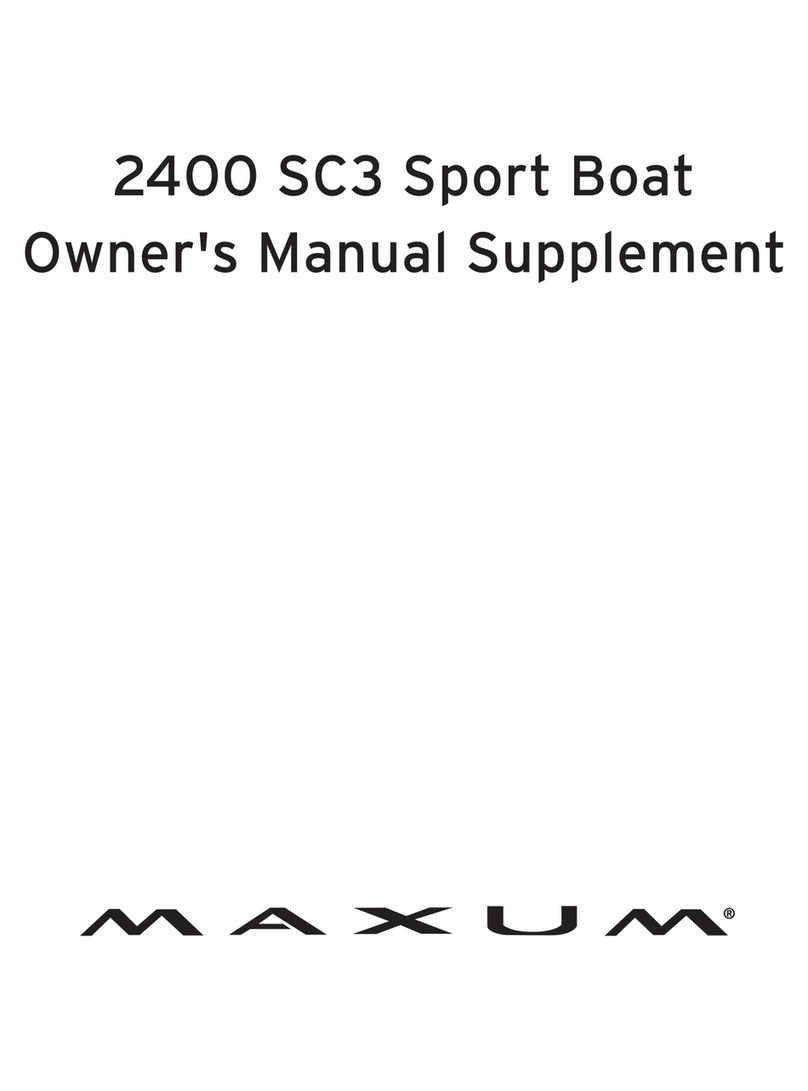
Maxum
Maxum 2400 SC3 Owner's manual supplement
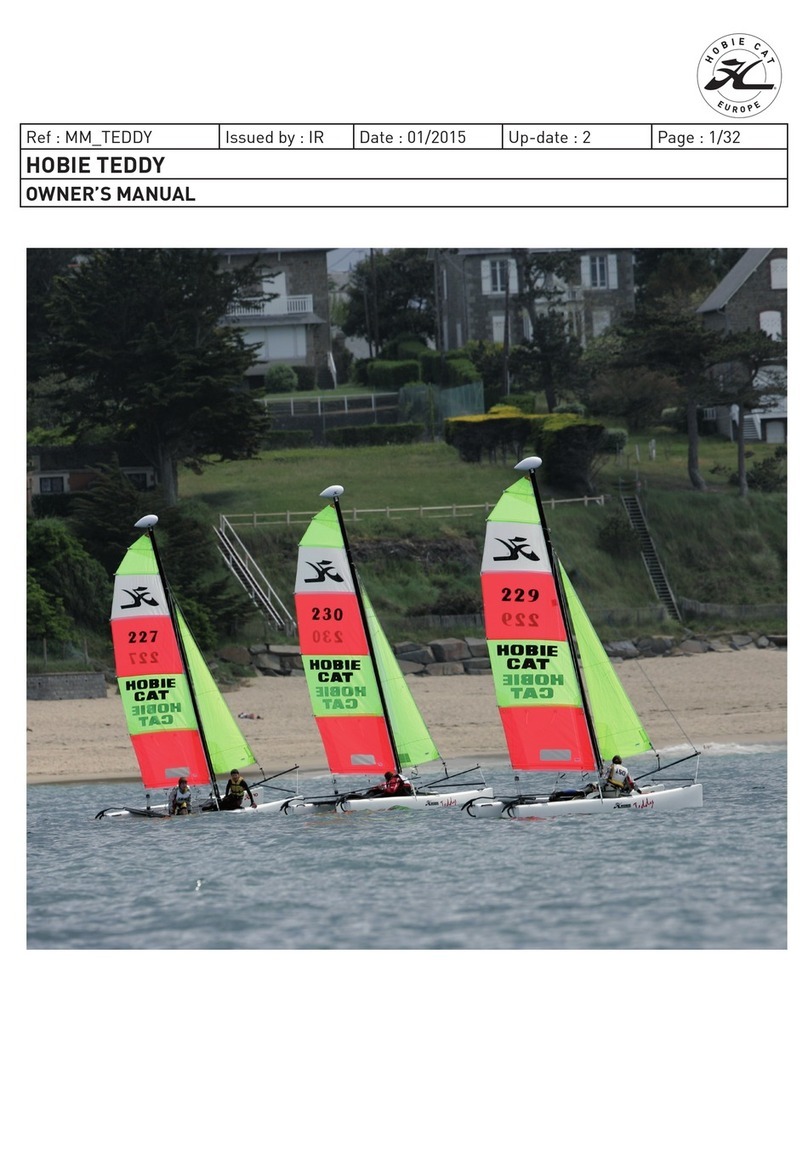
Hobie
Hobie teddy owner's manual
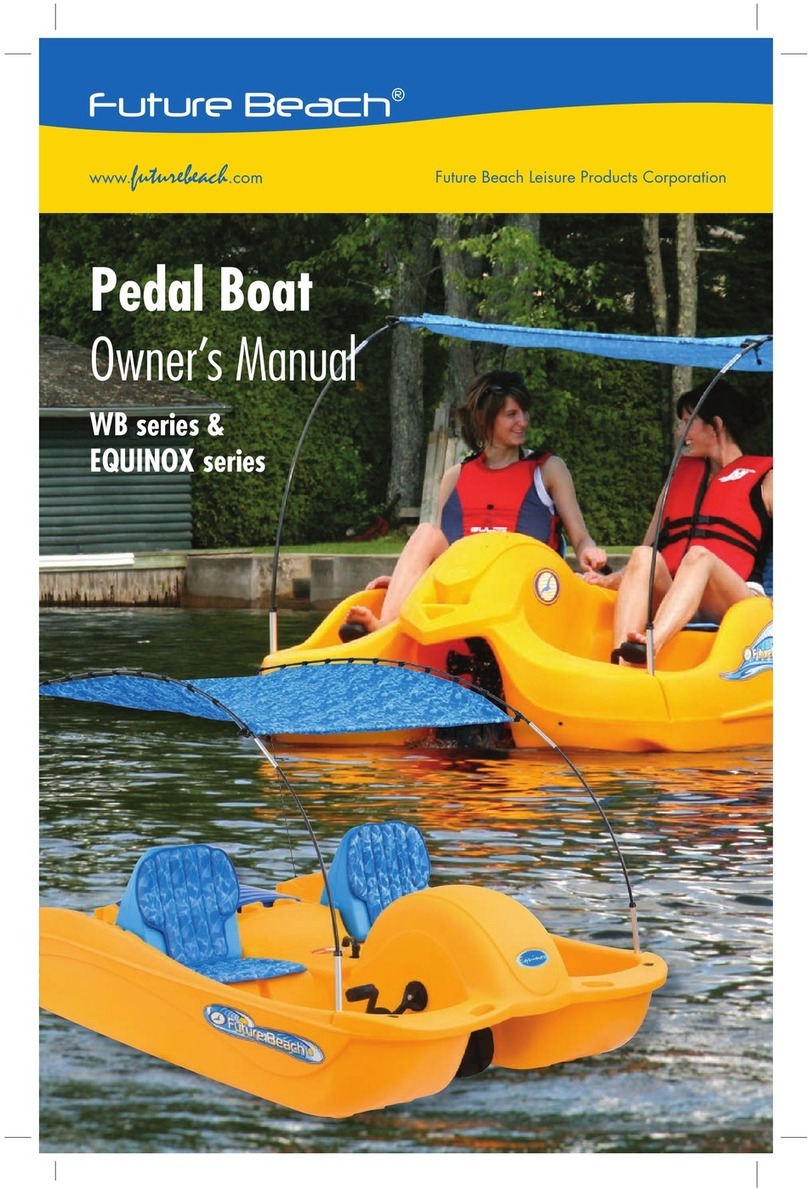
Future Beach
Future Beach WB series owner's manual

Yamaha
Yamaha WaveRunner VXS 2014 Owner's/operator's manual
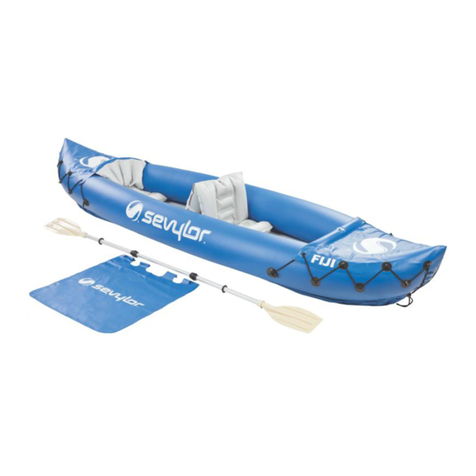
Sevylor
Sevylor 1 Person Sit On Top Kayak (Non Covered) instructions
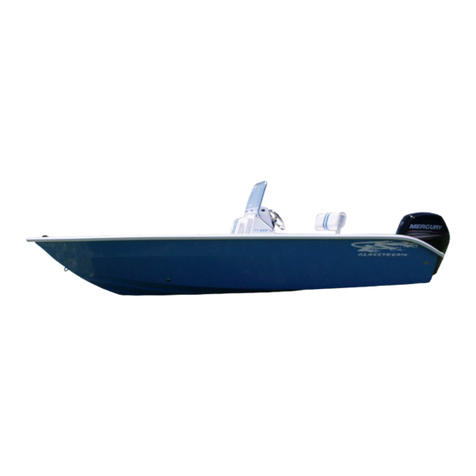
Glasstream Powerboats
Glasstream Powerboats 17CCR owner's manual
